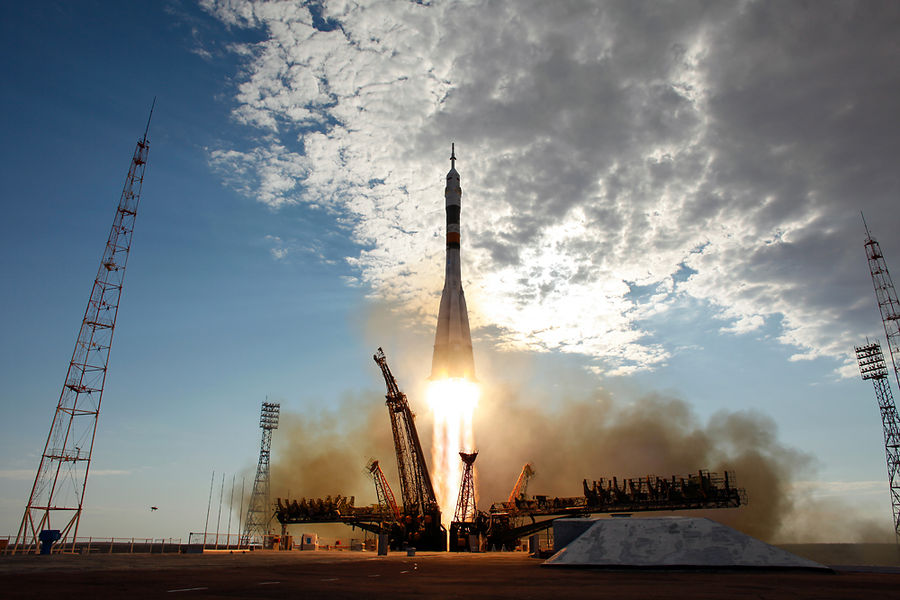Kazakhstan plans to launch two satellites into orbit for scientific and technological purposes from its southern Baikonur cosmodrome, the world's first and largest operational space launch facility, sometime in early 2018.
“The project itself will cost 6.6 billion tenge ($20 million) and the cost of launch is $2.6 million,” said Marat Nurgujin, Deputy Minister at the Defense and Aerospace Ministry, at the parliament last Monday.
An American-made Falcon-9 two-stage launch vehicle will carry both satellites into space, where three other Kazakhstani satellites are currently in operation. Astana will for the first time use an American-made rocket carrier for its satellites, forgoing Russian Proton launchers, which it has used previously.
The Falcon-9, first launched in 2012, is considered superior to the Russian-made Proton M, which had been introduced in 2007. Falcon-9 utilizes two stages to minimize the number of separation processes that take place in the earth’s atmosphere, while Proton M is a three-stage launcher.
The mission of the first satellite, designed by a team of Kazakhstani and British engineers, will enable remote sensing of the Earth at medium resolution. The second, which was wholly designed by Kazakhstan, is to help develop methods for forecasting earthquakes.
“Realization of the project will let [us] know about the flight story of Kazakhstani technologies and consequently reduce the cost of future satellites, [as well as] increase Kazakhstani contributions to producing future space systems and apparatus,” Defense and Aerospace Minister Beybut Atamkulov said to parliament.
Central Asia has a growing demand for high-quality telecommunications infrastructure, including Internet access and data transfer services. As the largest, economically strongest and wealthiest country in the region, Kazakhstan was the first of the five Central Asian Republics to launch a satellite.
KazSat-1 went into orbit for a 12-year mission after being transported to space via the Russian-made Proton-K launcher in 2006, although partial control of the satellite was lost in July 2008 and completely in October 2008. The telecommunications satellite, valued at $100 million, is equipped with 12 Ku-band transponders and links remote areas in Kazakhstan, Turkmenistan, Uzbekistan, Kyrgyzstan and part of Russia through broadcasting and telephone services.
The launch of the second and third telecommunication satellites, named KazSat-2 and KazSat-3, were launched in 2011 and 2014 respectively from the Baikonur Cosmodrome, also via Russian-made Proton launch vehicles. Both were aimed at broadening the scope of information services provided to the region, including mobile and internet connections, and helped satisfy Kazakhstan’s need for broadband systems.
KazSat-3 provides Direct-to-Home television services, broadband services and high-speed voice and data transmission services through Very Small Aperture Terminal (VSAT) technologies, for customers in Kazakhstan and surrounding regions.
The government of Kazakhstan owns almost all radio and TV transmission facilities and operates national TV and radio networks. Three state-run TV channels (Kazakhstan, KAZsport, Balapan) and four radio stations (Kazakh Radiosy, Shalkar, Astana, and Classic) the country, alongside several commercial radio stations. Households have access to foreign media via satellite dishes.
Recently passed legislation makes digital broadcasting mandatory for all TV channels by 2018, and requires all media outlets to register with the government. According to US government data, it is estimated that broadcast services reach over 98 percent of the population as well as neighboring countries.
Kazakhstan comes in at number 45 among 217 countries in terms of the number of Internet users in the country, which stands at 13.23 million and accounts for nearly 73 percent of the population.
All five countries within the Caspian basin are orbital-launch-capable countries, including Russia (1957, Soviet era), Iran (2005), Azerbaijan (2013), Kazakhstan (2006) and Turkmenistan (2015).







 Russian peacekeeping forces, deployed in the Karabakh (Garabagh) region of Azerbaijan since 2020, have commenced their withdrawal from the area.
Russian peacekeeping forces, deployed in the Karabakh (Garabagh) region of Azerbaijan since 2020, have commenced their withdrawal from the area.
 Iran's senior military leaders described the drone and missile attack on Israel on April 14 night as “successful".
Iran's senior military leaders described the drone and missile attack on Israel on April 14 night as “successful".
 Azerbaijan officially unveiled the logo for the upcoming 29th session of the Conference of the Parties to the United Nations Framework Convention o...
Azerbaijan officially unveiled the logo for the upcoming 29th session of the Conference of the Parties to the United Nations Framework Convention o...
 Iranian President Ebrahim Raisi warned Israel that it would face a "real and extensive" response if it makes any "mistake" following Tehran’s missi...
Iranian President Ebrahim Raisi warned Israel that it would face a "real and extensive" response if it makes any "mistake" following Tehran’s missi...



